The morning is different for each of us: Mihai goes to the Prefectural Art Museum of Hiroshima to see “The Dream of Venus” by Dali, Ioan does Calculus, and I am doing domestic things. At 11 we board the train to Himeji and arrive in no time. It takes more time to find an empty locker, all the ones from the train station are taken, but eventually we find plenty in the bus station.
 |
| Hydrant hidden in the sidewalk. |
We walk along the boulevard that takes us to the castle and take in the window shops and the statues. Between them, a guy sells persimmons and we are happy to buy, they are better than the ones from store.
At the end of the avenue there is a huge plaza with multiple crossings. The lights are red, everyone waits patiently, cars and people the same and there is nothing moving as far as I can see. I just blatantly cross the street (because I am tired of their rules, and respecting the rules, of how much I’ve seen and we are not in Kyoto yet, and I think I’ve just entered that wall where nothing can incite a feeling).
 |
| I bet that the guy on the right side is gelous! |
Above all, the castle looks serene and free, like a gliding white heron.
 |
| A blooming cherry in October. |
Entering the castle grounds, memories are coming back like everything happened yesterday, it does not seem that four years have passed. Nothing is changed, well, just the people. And the castle re-opened in March 2015. For six years they toiled, dismantling everything, repairing, understanding how it works, rebuilding in the same manner with the original methods (see Himeji). There was another restoration almost fifty years ago and they found writings about the process of building which they used for this one. They’ve reinforced the foundations to resist in future earthquakes. They've installed water pipes and a spraying system in case of a fire. And they’ve replaced the roof tiles and repaired the walls of the Main Keep.
 |
| How the castle grounds used to look: three moats, ordered houses and streets. |
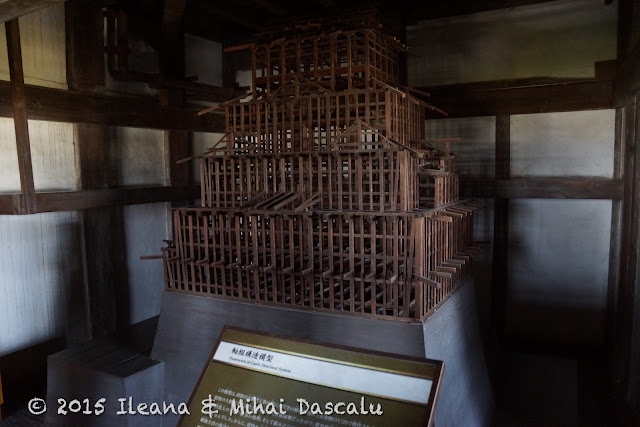 |
| A wooden model of the main keep that was used in the restoration from the '50s. |
 |
| The fish, a water element, would protect the roof and castle from fire. |
 |
| You can see a fish at each end of the roof, plus the blooming cherry on the right side. |
 |
| These round tiles that are found at the end of each row of oval roof tiles display the seal of the daimyō, of the lord. When they restored the first time, they found a few installed upside down. Not knowing if it had a special meaning they took care to install them as they have found them. Not know, they all sit as they should be, right side up. |
We put our shoes in a bag and carry them for the rest of the visit. With the exception of the size, the castle is the same as the one from Matsumoto, same wooden floors, same hooks on the walls to hold the bows, spears or guns, a different design but same metal ornament to hide the nails, different trees, but the same two poles that center around them five floors of castle and uphold a sixth one.
For a while everything goes smooth, and at the third level we hit a bottleneck: steep narrow stairs.
 |
| This is the downward equivalent of the upward steep stairs. I like their different styles of descending. |
Nothing in the rooms, this is minimalism to the extreme.
On the sixth floor we have the altar and the all around view.
The downward circuit is quick, people think that they have seen everything going up. Not quite! There is mushakakushi, a hiding room, in which a small number of samurai, would wait without a sound, and jump out if their lord needed their presence (watch Kagemusha, by Akiro Kurosawa, they filmed it right here). And in the basement there are the lavatories, large wooden rooms with wooden drains.
 |
| They did not translate a word Hairanaide kudasai, PLEASE do not enter |
We exit the keep and walk between walls and buildings, go through gates each one special, either by design or execution or role. One of them is at the end of a short flight of stairs in L, between high walls. It is so small, I almost have to crawl. There are no wooden doors now, but when they were, they could bolt them and fill quickly the space with rocks and sand, if there was a small sign that they could be breeched.
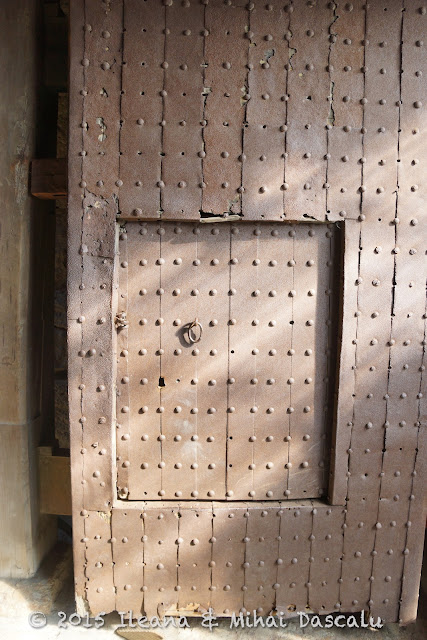 |
| The gates are reinforced with thick sheets of metal fixed with metal rivets. |
 |
| Nu-no-mon, the Nu gate is the only one with three levels: the gate itself, covered in black iron, the second floor with hidden stone drops, and the tower. |
 |
| The larger door is a yard tall. |
We read those side signs and find out that the walls have a curved design, like a fan, to make them stronger, that they used any kind of stone, hexagonal from the lamps or tomb ones, even a mill stone (though this one has a story: an old widow, who was earning her living selling rice-cakes in the market, hearing that the lord needed stones for building the castle, brought her own hand mill stone, and her generosity inspired many others to bring stones).


We try to peek in the well through the wires: water and some coins, but no Okiku, and no plates. The legend goes that there was a daimyō, a lord, on his death bed. The chief retainer wanted to rule instead of the heir. The heir sended Okiku to work for the chief, so he could find out his plans. The chief liked Okiku and asked her to be his lover. She refused many times. Eventually, trying to coerce her, the chief hid one of the ten treasured plates of the lord and accused Okiku, saying that he would vouch for her if she consents. Her refusal enraged the chief, who slew her and threw her in the well. And so, every night she rose from the well to count the plates to nine and, not finding the tenth one, started shrieking, haunting the chief retainer. The story tells no more about the lord and his heir, I presume the first one died and the other one followed in his place.
Outside of the castle grounds around the sides of the large courtyard there is an exhibition of chrysanthemums. Manicured ones or some that resemble bonsai they are the embodiment of many hours of work for the fleeting joy of one October afternoon.
 |
| Between the yellow of the courtyard and the tree line there is a faint red-brown line: right there are the chrysanthemums. |
Then we go to Koko-en, the garden that was built 23 years ago where the samurai housing used to be. Last time when we visited there was a watchman who mimed his out-loud spoken English words: “Hurry-hurry, slooowly-sloooowly” meaning we should hurry because it is closing time, but slowly, so we can savor the beauty. Our memories said we didn’t see it in its entirety, but strolling through its nine different Edo-style gardens we discovered that we did. They are still training the branches of the same tree to grow in a zig-zag manner as four years ago, the ladder is in the same place. And it feels good to be in a quiet place. The revolt and spiritual tiredness from this morning have disappeared. They were healed by the beauty that transcends from the surrounding work of love.
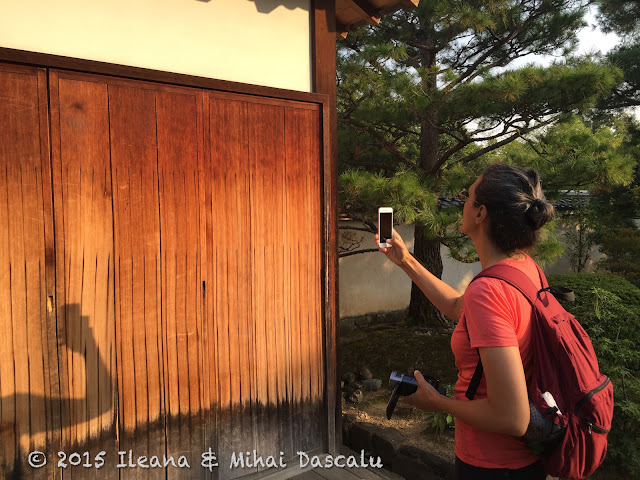 |
| The doors that protect the tea-room have nails that bleed rust from the humid air. The gray lower part is the one kissed by rain. |
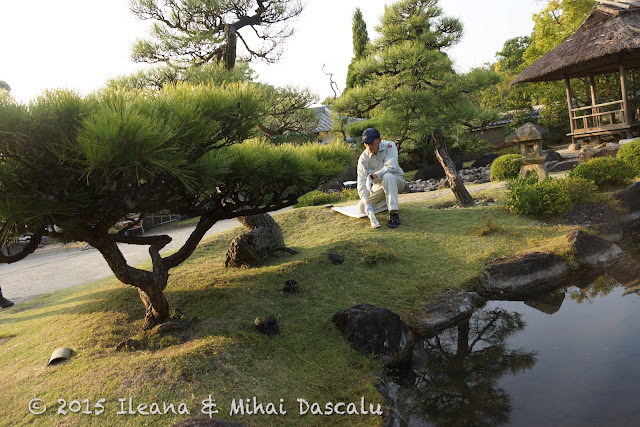 |
| Hand-mowing the grass. |
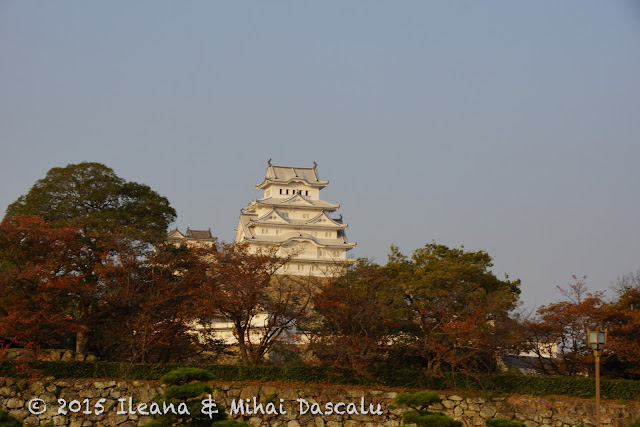 |
| The castle seen from the garden. |
Physically tired and hungry we hurry up to the train station, buy dinner, find our seats and eat. This is our last train trip. The JR pass will be obsolete tomorrow, past its two weeks term. We arrive in Kyoto and we are flooded with memories from our first stop in our RTW. We enjoy the moment like children, take pictures with the emblematic tower, babbling about what we did and how we went, while waiting in line for the taxi.
At the apartment we follow instructions: open the bicycle locket, take the card, enter the building, then elevator, room 302, push a button on the door to activate the card, THEN we can use it to open the apartment. If we forget it in the room it costs 20,000 yen ($180) to call the manager to open the apartment. If we lose it, its 50,000 ($450). We guard it like the Crown Jewels.
The apartment is small, well equipped and compartmentalized and we quickly settle in. There is not much room to move if we are in. We leave Ioan home and we go food-shopping for our first few days in Kyoto, a difficult task since we are tired. I notice that they sell mums for eating. I don’t want to eat ramen anymore so we buy vegetables and udon (it resembles thick spaghetti), plus some sweet wine. Back home: laundry, onsen, blog, etc. Tomorrow we start visiting Kyoto…six days….seventeen UNESCO sites…plus whatever could not make that list…
Are you ready?














































No comments:
Post a Comment
Comment form message here